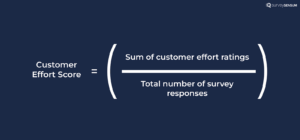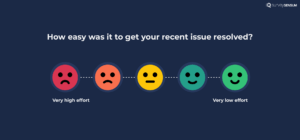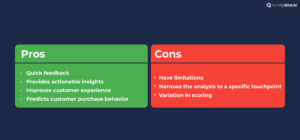Innovative Team Collaboration: 3 Tools for Seamless Project Management
Read More

In today’s competitive market when we talk about customer experience, we’re not just talking about flashy features or catchy ads. It’s about how smoothly customers can use your products, access your services, and get help when they need it.
This is where the Customer Effort Score (CES) steps in.
CES is a metric designed to gauge the level of effort customers have to put forth when engaging with your company.
Calculating Customer Effort Score (CES), with the help of efficient CES software, is a way for businesses to measure the ease or difficulty a customer is experiencing when interacting with their products, services, or support channels.
Now that you understand the why, let’s understand the HOW.
The formula for calculating CES is the sum of all the customer effort ratings divided by the total number of survey responses.
Here’s the formula:

For example, if you’re using a 5-point scale and have received the following responses:
The calculation would be:
CES = ((10 * 4) + (15 * 5) + (5 * 3)) / (10 + 15 + 5)
= (40 + 75 + 15) / 30
= 130 / 30 = 4.33
So, the Customer Effort Score in this example is approximately 4.33.
Tip: The scale you use (e.g., 5-point or 7-point) influences the possible range of scores and the interpretation of the results. It’s important to use the same scale consistently to ensure meaningful comparisons over time.
How Can You Improve Customer Satisfaction with CES Surveys? – Request a Demo

Now you know the why and how of calculating the customer effort score, but the question that arises here is – what can be considered a good customer effort score?
Determining a “good” CES score is not a one-size-fits-all endeavor. A good customer effort score depends on factors such as the wording of the customer effort score questions, the scale used for responses, and industry benchmarks.
Generally, a lower CES score indicates that customers find it easy to engage with your company, while a higher score suggests more challenges and frustrations.
For example, if your scale has 1 as the minimal effort and 5 as the highest effort given by customers then anything between 1-2 would mean customers don’t face many issues, whereas anything above 4 would mean that customers often struggle. And 3 would mean neutral opinion.
It is crucial to establish your own baseline of what constitutes a good CES score. This is best achieved by analyzing your own data, comparing trends over time, and aligning the score with customer expectations.
There are 2 ways businesses can benchmark their CES to understand where they stand in terms of customer effort.
But there’s a catch, let’s understand that.
Comparing your CES against competitors can be tricky. Unlike certain metrics that can be quantified with a universal unit of measurement, CES can vary widely because of the different wording of survey questions, the scales used for responses, and the context of the customer interactions being evaluated.
For example, a CES question on a scale of 1 to 5 will yield different scores than the same question on a scale of 1 to 10, even if customers have similar experiences.
Then what is the alternative solution to this?
Instead of solely focusing on comparing CES results with competitors, businesses can dig into their own data and history.
Compare your current CES scores against your historical data to understand patterns and trends.
‘Are there improvements over time? Are certain initiatives correlated with changes in CES scores?’
By examining your own journey, you can get insights into the effectiveness of your customer-centric efforts.
Now that we have covered the calculation and the customer effort score benchmark, let’s evaluate the pros and cons of CES.

Pros:
Cons:
Here are some points to consider if you want to improve your CES and boost customer experience:
By focusing on minimizing customer effort, optimizing touchpoints, and closing the feedback loop, you can create a seamless customer experience that aligns with your customers’ expectations and contributes to long-term success. Remember that the true value of your CES lies not just in the number, but in the actions you take.
Additionally, in order to minimize your CES you need to bank on an effective customer feedback platform that will help you in launching customized CES surveys, gather feedback in real-time, alert you of detractors, close the feedback loop, and much more!
If you are on the lookout for something like that then try SurveySensum!
